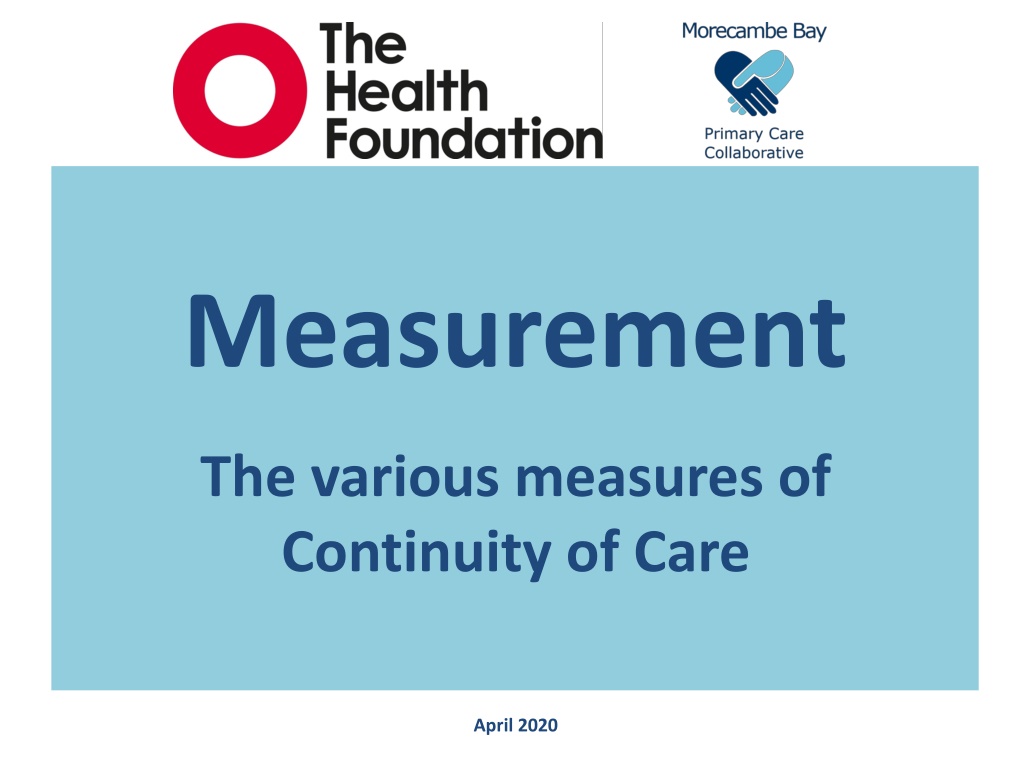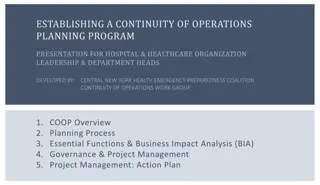Measures of Continuity of Care in Healthcare
This content discusses key measures of continuity of care in healthcare, including the Usual Provider of Care (UPC) index and the Continuity of Care index. The UPC index calculates the proportion of visits to a patient's regular care provider, while the Continuity of Care index considers both visit frequency and provider dispersion. Worked examples and formulas are provided for better understanding. These measures play a crucial role in assessing and improving the quality of patient care and are valuable tools for healthcare professionals.
Download Presentation

Please find below an Image/Link to download the presentation.
The content on the website is provided AS IS for your information and personal use only. It may not be sold, licensed, or shared on other websites without obtaining consent from the author.If you encounter any issues during the download, it is possible that the publisher has removed the file from their server.
You are allowed to download the files provided on this website for personal or commercial use, subject to the condition that they are used lawfully. All files are the property of their respective owners.
The content on the website is provided AS IS for your information and personal use only. It may not be sold, licensed, or shared on other websites without obtaining consent from the author.
E N D
Presentation Transcript
Measurement The various measures of Continuity of Care April 2020
Usual Provider of Care (UPC) Breslau N, Haug MR. Service delivery structure and continuity of care: a case study of a pediatric practice in process of reorganization. J Health Soc Behav. 1976:339 352. This index describes the proportion of visits to the patient s regular care provider out of all visits (excluding patients with <1 visit in the period). It ranges from 0 (no visit to the regular care provider) to 1 (all visits made to the regular care provider), when the regular care provider is known. If the Usual GP is not reflective of the regular care provider, UPC would need to be calculated for the care provider the patient visited most frequently, therefore the range will always start above 0. To determine regular providers, and to calculate UPC where no regular provider is defined where ?? is the number of visits to a regular physician by patient i, and N is the total number of patient i s visits to a physician. where max(?1, ?2, ... ??) is the number of visits to the provider with whom the patient had the greatest number of visits, and N is the total number of visits by the patient to all providers during the same period. If the sequence of visits was AAAABBBC, then the UPC is 4/8 = 0.50.
Usual Provider of Care (UPC) Worked example Where we know who is the regular provider: AAAABBBC has a UPC of 0.50 The patient had 8 consultations (4 with A; 3 with B; 1 with C) When we know A is the regular provider e.g. their Usual GP the calculation is 4/8 = 0.50 When we don t know who the regular provider is, the calculation is: Where we don t know who is the regular provider and have to calculate the most frequent provider: KEY: ?? = number of visits to a regular physician by patient i (Maximum value from 4,3,1)/8 = 0.50 Which is 4/8 = 0.50 N = total number of patient i s visits to a physician. max(?1, ?2, ... ??) = the number of visits to the provider with whom the patient had the greatest number of visits AAAAABBCCD has a UPC of 0.50 (5/10) AABBAACAAB has a UPC of 0.60 (6/10) AABCAABA has a UPC of 0.625 (5/8)
Continuity of Care Index Bice TW, Boxerman SB. A quantitative measure of continuity of care. Med Care. 1977:347 349. This index weights both the frequency of visits to each care provider and the dispersion (the extent to which values of a variable differ from a fixed value) of visits between care providers (excluding patients with <1 visit in the period). Index values range from 0 (each visit made to a different care provider) to 1 (all visits made to a single care provider). It rewards having fewer providers, which makes it a useful to measure of continuity when working in teams. k = the number of providers, ?? is the number of visits per provider i, N is the total number of visits to all providers in a given period. If the sequence of visits is AAAABBBC then the continuity of care is 0.32, while if the sequence of visits is AAAABBCC, the continuity of care is 0.29, although both have the same UPC (0.50).
Continuity of Care Index Worked example AAAABBBC has a COCi of 0.32 The patient had 8 consultations (4 with A; 3 with B; 1 with C) Calculation is: ((42+32+12)-8)/(8 (8-1)) = 0.32 Can be broken down to Which is ((16+9+1)-8)/(8 7) = 0.32 Which is (26-8)/56 = 0.32 KEY: Which is 18/56 = 0.32 N = total number of visits AAAABBCC has a COCi of 0.29 ??= the number of visits to the 'i'th provider, where i = 1,2, ... M The patient had 8 consultations (4 with A; 2 with B; 2 with C) Calculation is: ((42+22+22)-8)/(8 (8-1)) = 0.29 Which is ((16+4+4)-8)/(8 7) = 0.29 Which is (24-8)/56 = 0.29 M = the number of potentially available providers Which is 16/56 = 0.29 N.B. Both have the same UPC (0.50).
St Leonards Index of Continuity of Care Sidaway-Lee K, Pereira Gray D and Evans P. A method for measuring of continuity of care in day- to-day general practice: a quantitative analysis of appointment data. British Journal of General Practice 2019; 69 (682): e356-e362 [Available from https://doi.org/10.3399/bjgp19X701813] This index is designed to be a simple measure and can be undertaken by practices themselves for comparison within practice. It uses individual doctor s registered lists, applicable for short periods of time and includes patients with 1 appointment in that period unlike UPC or CoCi. However, it is based on a known/named/allocated GP/GP personal list. It can be used to compare groups of patients e.g. doctors list, whole practice, age groups and deprivation. U/N*100 = % U = Number of patients appointments (for a set group of patients) that are with their named/usual GP N= Total number of patient appointments (for the same set group of patients)
St Leonards Index of Continuity of Care (SLICC) Worked example U/N*100 = % All 10 patients usual GP = A All 10 patients usual GP = B U = Number of patients appointments (for a set group of patients) that are with their named/usual GP 1. AAAABBBC 1. AAAABBBC 2. AA 2. AA 3. ABACC 3. ABACC 4. BCAABB 4. BCAABB 5. ABA 5. ABA N= Total number of patient appointments (for the same set group of patients) 6. A 6. A 7. C 7. C 8. ABABA 8. ABABA 9. ACA 9. ACA 10. AAB 10. AAB 20/37*100 = 54% 11/37*100 = 29.7%























